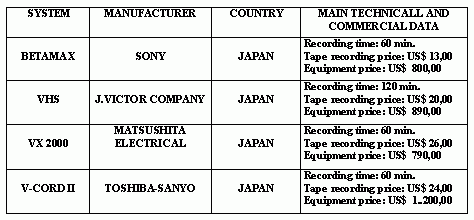|
In 1927, a Russian immigrant to Britain, Boris Rtcheouloff
had applied for a patent based on Valdemar Poulsen's invention
describing an apparatus for recording pictures and sound on
a travelling metallic wire.
During the early 1950's the recording of pictures and sound
was a very restritcted process used only for professional
applications, as known as VTR or Video Tape Recorder.
In the reality, the VTR had many advantages when compared
with earlier similar recording process, as it allows that
the video and sound signals could be recorded simultaneously
without any previous technical arrangements to obtein for
instance, the sound tracks like in the movie-pictures.
Furthermore in spite of its simple operation, the recorded
tape has a reduced demage rate during the playback mode and
in this way it can be used for many times easily.
Due to the continuous improvement in the chemical formulation
of the recording media used in the new magetic tapes as well
as in the desing of the new recording heads, the electronic
industry launched in the world market the first home video
recording systems, such as the U-MATIC, invented by Sony Corporation
in Japan. (a)
In the mid 1970's there were available four commercial home
video recording systems as per indicated in table (b).
 |
| (*) As known as VHS or Video Home System |
| Table 5: Showing diverse systems
recording and video signals reproduction for domestic
applications in the middles of the decade of 1970. |
However, due to several circunstances only the VHS system stayed
in the market consolidating the VCR or videocassette recorder.
It is interesting to note that simultaneously to the development
of the recording of the pictures and sound signals on magnetic
tape, engineers were working also in differents processes giving
birth of the videodisc.
In this way, in 1972, Philips demonstrated the first practical
long-playing videodisc technically far superior when compared
with its forerunner launched in 1970 by the joint venture TELDEC
(AEGTelefunke/Decca).
In theTELDEC sytem the pictures and sound signals were still
recorded in grooves using a mechanical tracking and so it had
a very low playback time up to 5 minutes. By other hand the
Philips system used an advanced concept of sub-microscopic dots
arranged in a spiral track whose reading was done by mean of
coherent light or - Laser - allowing a playback time around
30 to 40 minutes. (a)
|
|
|
 (d) Modern videocassette recorder
using the VHS sytem made by Panasonic. (Courtesy of
Panasonic do Brasil)
(d) Modern videocassette recorder
using the VHS sytem made by Panasonic. (Courtesy of
Panasonic do Brasil) |
|
(a) Recording head used in a modern
home video recorder.
|
(a) Pictorial aspects of the evolution
of the video tape recorders:
(a) Video tape recorder using
the U-MATIC system launched in the market circa 1971.
(b) Forrunner of the model VCR using the BETAMAX system.
(c) First solid state VTR circa 1964.
|
|